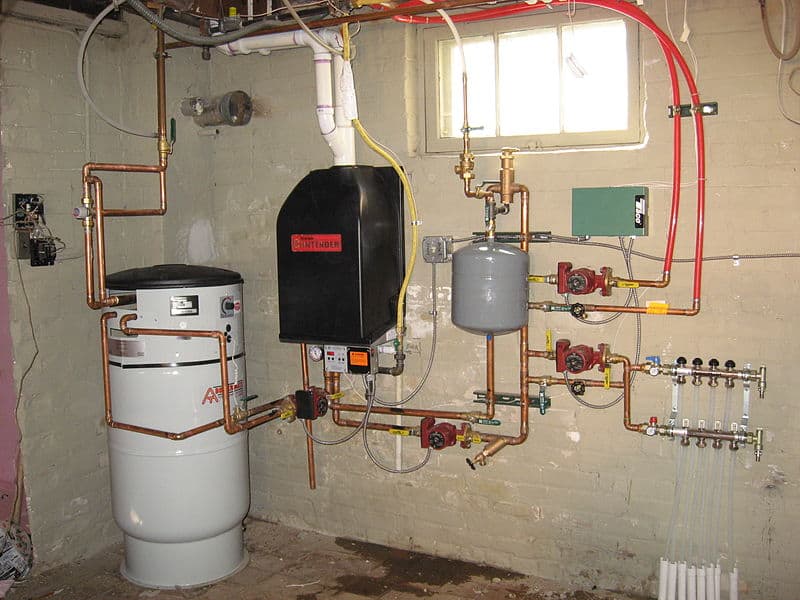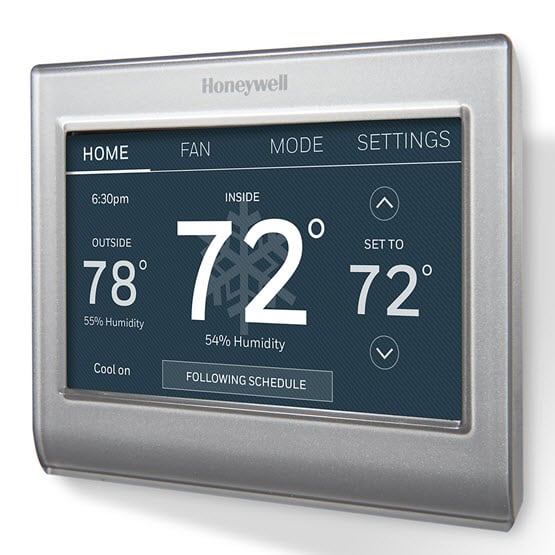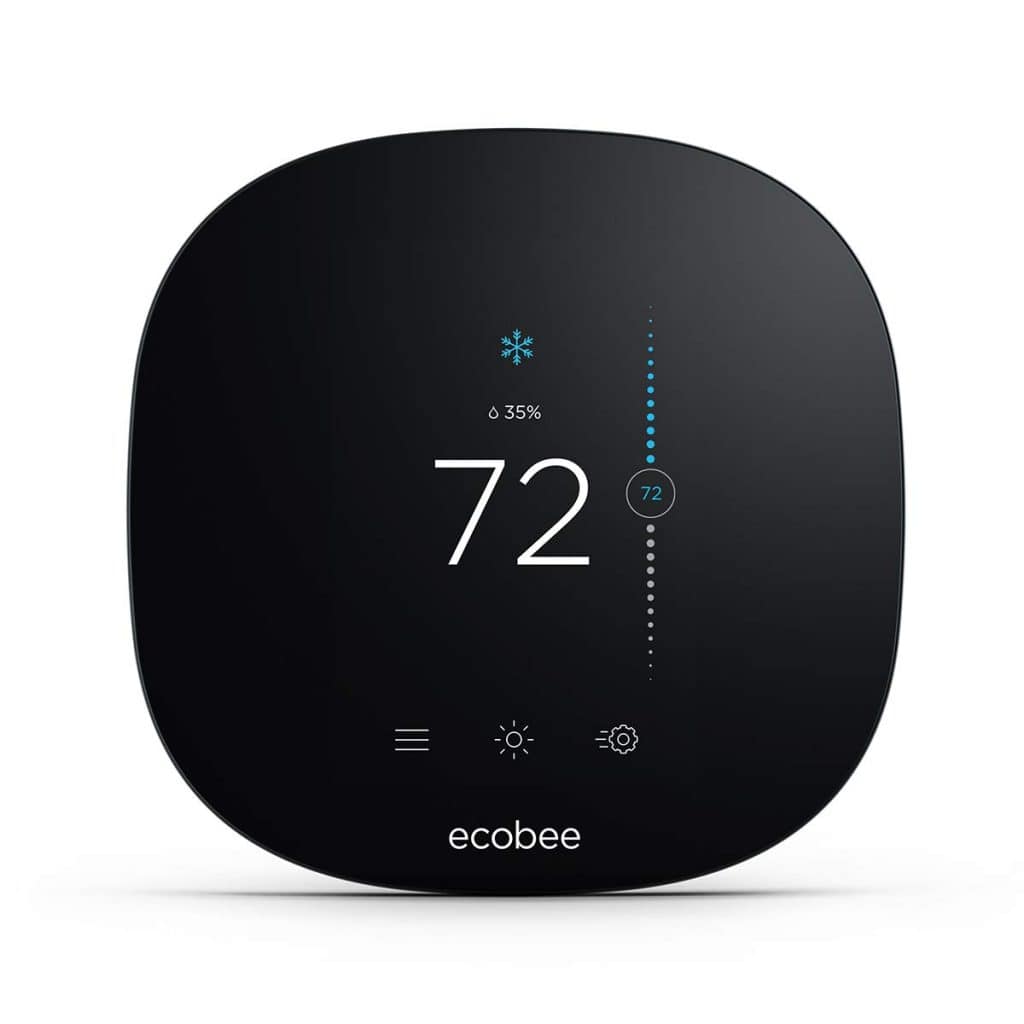A “central heating thermostat” – is just the same regular thermostat that is used to control a central heating system. In the USA, the two most commonly used central heating systems are a boiler or a furnace. A central heating system produces heat at one point (usually set up in the basement area or a furnace room) and distributes heat to the whole building by forced air through ductworks (in the case of a furnace) or as hot water/steam through pipes (in the case of a boiler). A thermostat that is compatible with a central heating system can be called – a central heating thermostat; that is a thermostat compatible with a boiler system or a central furnace.

As we’ve mentioned in our other guides, about 90% of homes in the USA are using heating systems like a boiler or a furnace or a heat pump. When a central heating system is combined with other systems (like ducts/pipes for heat distribution, thermostats for temperature control, cooling coils) – it forms a complete HVAC system. Therefore, we’ve published guides featuring Central Furnace Thermostats and Central Boiler Thermostats – both guides covering smart, WiFi, and programmable thermostats compatible with central heating systems.
Central Heating Thermostat Types
A handful of choices are available as central heating thermostats – which can be WiFi/Wireless heating thermostats, or smart thermostats, or digital programmable thermostats for central heating systems. Out of these 3 models, smart thermostats are the most modern type with advanced features like self-learning, energy savings, internet-based control using smartphones, geofencing, and a lot more. If you’re price-conscious, go for a normal digital programmable heating thermostat, which would be budget-friendly.
Best Central Heating Thermostats
We’re living in an “internet-connected” era and most people prefer connected smart devices these days. Internet-connected devices often provide us with great convenience as they can be controlled from anywhere using smartphone apps. Most of the new generation thermostats like Nest, Ecobee, Emerson Sensi, Honeywell RTH9585WF – are all WiFi-enabled thermostats suitable for any central heating system (be it a boiler or a furnace). All these wireless central heating thermostats can be connected to your home WiFi and they can be controlled from anywhere using the respective mobile apps.
Out of the 4 models listed above, Nest, Ecobee, and Sensit ST75 are “smart thermostats” with high-end features like energy savings, auto programming, geofencing, and other useful features. Let’s go through all of them in a nutshell.
#1 Ecobee 4 and Ecobee 3 Lite
We’ve covered full review of Ecobee 4 and Ecobee 3 Lite – where we have detailed features, compatibility, comparison between the two models, and a lot of other useful information. Ecobee 4 is the full-featured model with built-in Amazon Alexa and comes with an extra room sensor to set up a zoned system (to manage any hot/cold spots in your home). Ecobee 3 Lite – is the budget model central heating thermostat, which is basically a trimmed-down version of ECobee 4. There is no built-in Amazon Alexa and no room sensor is provided with Ecobee 3 Lite.
Compatibility
For Boiler – Both ecobee models are compatible with central heating boilers. They support 2H/2C – Two stages of heating and Two stages of forced air cooling.
For Furnace – Both ecobee models support central furnace heating systems. They are compatible with single-stage systems and multi stage systems (upto 2H/2C – Two stages of heating/cooling)
Note: We’ve covered compatibility of all popular thermostat models in our guide.
#2 Nest 3rd Gen and Nest E
Nest 3rd Gen is the full-featured model with “self learning”, energy savings, geo fencing and a lot of other smart features. Nest E is the budget model with differences in build quality. The key difference between Nest 3rd Gen and Nest E is in their compatibility. Nest 3rd Gen is compatible with 90% of HVAC systems, whereas Nest E is compatible with only about 80% of HVAC systems in use.
We’ve reviewed Nest 3rd Gen and Nest E – in our comprehensive guide covering all aspects & comparisons. Read through our guide, if you’ve Nest models in your mind.
Compatibility
For Boilers – Nest 3rd Gen supports up to 2H/2C (two stages of heating/cooling). Nest 3rd Gen also supports dual transformer configuration. Nest E supports up to 2H/1C only (two stages of heating and one stage of cooling). Nest E doesn’t support dual transformer configuration.
For Furnaces – Nest 3rd Gen supports up to 2H/3C (two stages of heating and three stages of cooling). Nest E supports only up to 2H/1C (two stages of heating and one stage of cooling)
#3 Emerson Sensi ST75

Emerson Sensi ST75 is a value-for-money WiFi central heating thermostat with lots of useful features like energy savings, voice control, geo-fencing, internet control, and more. The only feature Sensi ST75 lacks is “self-learning” which is commonly found in smart thermostats like Nest and Ecobee.
Compatibility
For Boilers & Furnaces – Sensi ST75 supports upto 2H/2C – two stages of heating and two stages of cooling for both boilers and furnaces.
#4 Honeywell RTH9585WF

Honeywell is still one of the market leaders in thermostats, as they have models covering different budgets and different types of HVAC systems. “Honeywell RTH9585WF” – is one of the best-selling WiFi central heating thermostat models suitable for central furnace and boiler-based HVAC systems. This model comes with a big, color, touch screen display – where the color of the touchscreen interface can be changed to suit your room interiors. The model also has voice control enabled – and is compatible with Amazon Alexa, Apple HomeKit, Google Home, and other smart home hubs.
Compatibility
For Boilers & Furnace – Honeywell RTH9585WF supports up to 2H/2C – that is 2 stages of heating and 2 stages of cooling. The fan is supported for electric furnace models. Other accessories like humidifiers and ventilators are not supported.
Thermostats for Central Heating Furnace
A furnace-based central heating system mainly involves a central furnace set up at one point, and the heat produced in the furnace is distributed through ducts as warm air. Natural gas is the commonly used energy source in a central furnace. In the USA, around 49% of homes are powered by natural gas-based central heating systems (source). Other than natural gas, Electricity based heating systems (nearly 33% of households), fuel oils (6%), propane/LPG (5%), wood (2%) are also used as energy sources in a central furnace.
The heat produced in a furnace is used to heat the air in a heat exchanger. The warm air is then distributed with help of blowers (forced air), through ducts which are passing through each and every room. A central furnace is a relatively cost-effective heating system, compared to a boiler or other systems.
Thermostats for Boiler Heating Systems
Boilers – as the name implies, use hot water distribution through pipes installed in different rooms. A boiler unit is set up at one point (usually in the basement) and water is heated to the desired temperature (not really till the boiling point). The hot water is then passed through radiators and pipes installed throughout different rooms, where they release heat from hot water while passing. Most commonly, boilers use “natural gas” as a fuel source. However, heating oils, electricity, propane/LPG, wood are also used as fuel sources to produce heat.
Boilers are costly to install compared to central furnace heating systems. The reason for the high cost is pipes & radiators which have high material cost compared to setting up air ducts. The key advantage of a boiler is the ease of setting up “zoned systems” where each individual room can be set as unique zones – which can be controlled using thermostats installed in each room. Central furnace-based heating systems are not ideal for setting up zoned systems.




